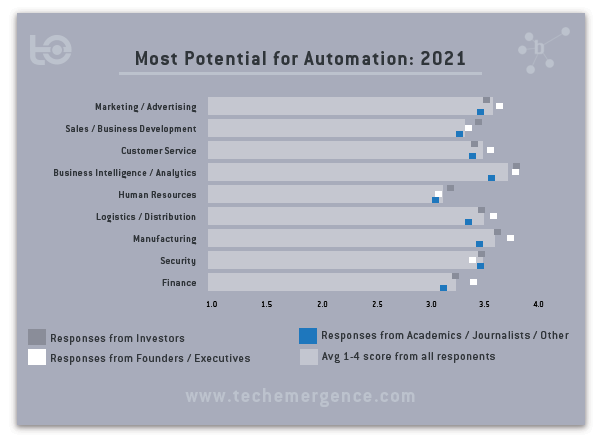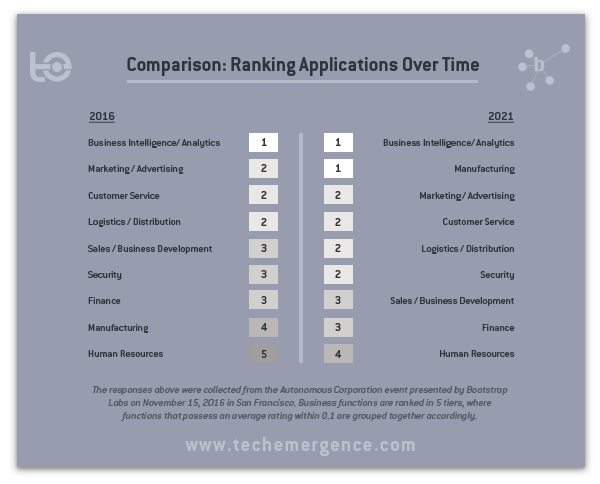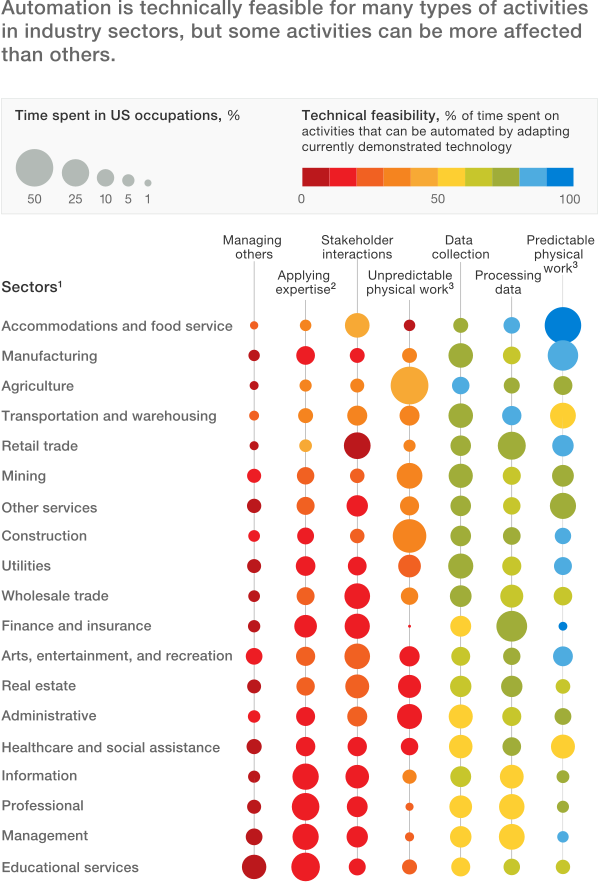In November 2016, TechEmergence collaborated with BootstrapLabs and created a simple survey on job automation potential, which was handed out to participants at BootstrapLabs’ “Autonomous Corporation” event in November 2016. About 80 Bay Area investors, founders, and other tech industry aficionados responded, providing their insights on which business functions—marketing/advertising, business intelligence/analytics, security, etc.—have the greatest potential for automation in 2016, as well as in half a decade from now. Below are highlights of the survey results, along with noted external research trends that paralleled, expanded upon, or differed from our own findings.
Here and Now - Job Automation in 2016
Participants—separated into categories of investors, academics/media, and founders/executives—ranked their answers on a ‘most potential’ scale of 1 to 4. In surveying job automation potential for business functions in 2016, participants on the aggregate tended toward the middle of the spectrum, with an average 2 confidence.

Overall, the top 3 potential for job automation overall (across category of participant ) were (in order from greatest to least) Business Intelligence/Analytics, Marketing/Advertising, and Logistics/Distribution. As a lone category, investors tended to rank categories more or less the same as overall participants, though they placed a slightly higher job potential on Customer Service over Logistics/Distribution, which seems in line with recent developments in natural language and chatbot capabilities.
The academics/media group also fell into almost even agreement on job potential with other participants, though they gave Security as having the same potential as Marketing/Advertising. Founders/executives also fell into line with the overall trend, but were more confident about Marketing/Advertising (which they ranked as first) with Business Intel/Analytics pulling a close second. Overall, investors were (in general) the most optimistic in how far along we are overall in job function automation in 2016.
Down the Road - Job Automation in 2021
Increased potential for automation across all job function categories was the most obvious difference five years into the future, with all participant groups evening out closer to 4, or the most optimistic end of the spectrum. Responses in regards to job function potential were more or less the same as in 2016, though Manufacturing catches up with Marketing/Advertising, with Customer Service and Security closing gaps alongside Logistics/Distribution.

Almost across the board (with a couple of exceptions), academics/media were the most “pessimistic” group in terms of outlook on automation potential in five years’ time, meaning they tend to believe society will be less close in achieving more automation. Founders and executives tended to be the most bullish for automation in 2021.
The Autonomous Corporation
In addition to scoring job functions in terms of automation potential, guests at BootstrapLabs’ event were asked the following question: “When might you expect to see full autonomous corporations - where decision-making, operations, and finances are executed without human interference?”
The results can be seen in the graphic below:

External Research Insights
Parallels and Differing Perspectives
While there may be varying definitions of job automation depending on source, TechEmergence chose a set of criteria, defined in a recent article published by Harvard Business Review, that identifies those jobs primed for automation as “work that can be codified into standard steps and of decisions based on cleanly formatted data” i.e. any job that is routine and data intensive. For example, compliance recordkeeping (ripe for disruption by automation).
In a 2015 study released by Ball State, manufacturing—specifically in computer and electronics—was hit hardest by automation, from 2000 to 2010, resulting in a production increase (per worker) in 350.3 percent. McKinsey & Co. recently released a study investigating the intersection of machines and humans in the workplace, which also analyzed work activities as opposed to specific occupations, though their research further drilled in on more specific tasks within industries.
According to existing data from the U.S. Bureau of Labor Statistics and O*Net, McKinsey found that about 60 percent of all occupations could see 30 percent or more of their work activities automated over the next decade, based on current technologies. While this isn’t full automation, it does support the notion that almost all occupations will be affected by related automation technologies by 2026.
Perhaps not surprisingly, McKinsey’s analysis highlights physical activities or jobs that require operating machinery in a predictable environment— including functions in sectors such as manufacturing, food service and accommodations, and retailing—as the most vulnerable to automation or 78 percent. Though we won’t reference others, the McKinsey article (cited above) provides a more detailed analysis on positive likelihoods of automation in specific occupations.

By contrast, the hardest activities to automate included tasks involving the management of people or those that require a level of expertise in making strategic decisions and planning (9 percent automation potential), as well as creative work (18 percent automation potential). These types of tasks are inherent components in the business functions that TechEmergence and BoostrapLabs survey categories, though McKinsey further broke down specific types of tasks within a particular industry.
As important as it is to hear from experts and leaders working with or having been exposed to artificial intelligence and automation technologies, it’s also useful to get a pulse on the public’s sentiment regarding such technologies. Research from Pew gathered longer-range perspectives on job automation potential from the “average” American in a 2015 survey that included responses from 2,001 adults. About 65 percent of participants expressed the belief that within 50 years, robots and computers would “definitely” or “probably” be doing much of the work that humans are doing today; however, in what seems an ironic twist, 80 percent of these same participants also believed that their own jobs would remain more or less unaffected and that their positions would exist in a similar form 50 years from now.
Even more interesting were the average demographics inherent in this segment’s aggregate beliefs: a higher percentage of adults under 50 with higher education levels were more likely to believe their jobs would remain largely unaffected by automation, as were those who worked for government, nonprofit or educational roles. There seems to be a parallel between these beliefs and references to artificial intelligence, by some interviewees featured on TechEmergence, as a means of augmenting (instead of replacing) higher-level oversight and creative positions. In addition, the McKinsey study identified education roles as having (currently) the least potential for automation. Yet that study, and many of our interviewees, are looking a decade out - not 50 years into the future.
While we and leading experts in the field can speculate about the progress of automation in five to 10 years’ time and its affect job functions, how artificial intelligence technologies may affect the job market 50 years from lies strictly in (and likely beyond) our wildest imaginations.
